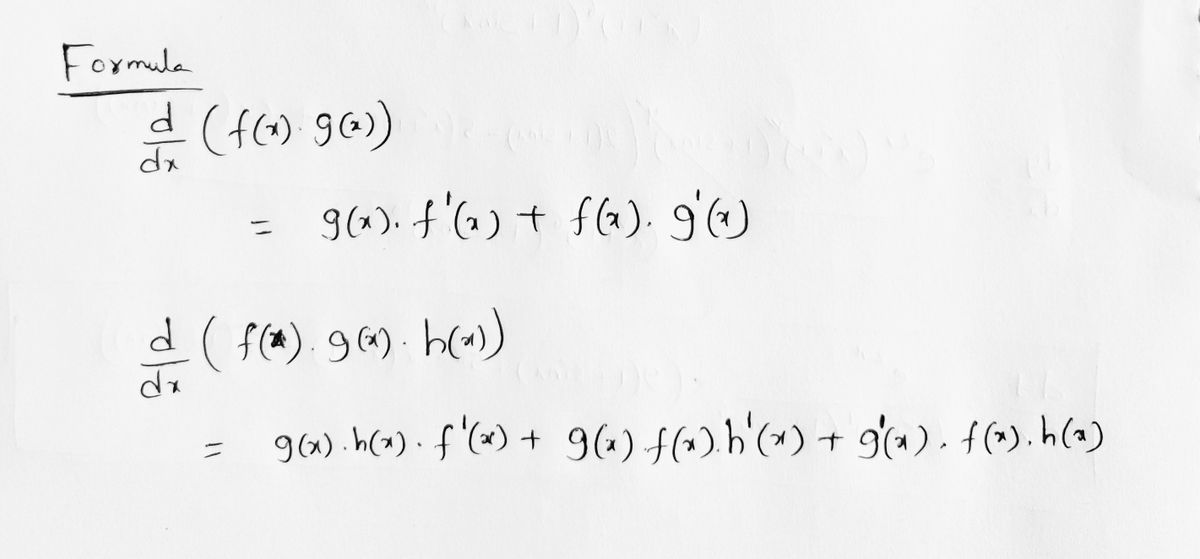Calculus: Early Transcendentals
8th Edition
ISBN:9781285741550
Author:James Stewart
Publisher:James Stewart
Chapter1: Functions And Models
Section: Chapter Questions
Problem 1RCC: (a) What is a function? What are its domain and range? (b) What is the graph of a function? (c) How...
Related questions
Question
![**Find the derivative of:**
\[ f(x) = 3^{2x} (x^2 + 5) \tan(5x) \]
---
**Explanation:**
This function involves a combination of exponential, polynomial, and trigonometric components. To find the derivative, apply the product rule, chain rule, and standard derivative formulas for exponential, polynomial, and trigonometric functions.
**Derivative Steps (General Outline):**
1. **Identify Components:**
- Exponential: \(3^{2x}\)
- Polynomial: \(x^2 + 5\)
- Trigonometric: \(\tan(5x)\)
2. **Use Product Rule:**
- The derivative of a product \(u(x)v(x)w(x)\) is given by:
\[ u'(x)v(x)w(x) + u(x)v'(x)w(x) + u(x)v(x)w'(x) \]
3. **Differentiate Each Component:**
- **Exponential Part:**
- Use the chain rule for \(3^{2x}\): \(\frac{d}{dx}[3^{2x}] = 3^{2x} \cdot \ln(3) \cdot 2\)
- **Polynomial Part:**
- Derivative of \(x^2 + 5\) is \(2x\)
- **Trigonometric Part:**
- Derivative of \(\tan(5x)\) is \(5\sec^2(5x)\)
Apply these derivatives to compute the entire expression, following your preferred method of organizing and simplifying the terms.](/v2/_next/image?url=https%3A%2F%2Fcontent.bartleby.com%2Fqna-images%2Fquestion%2Fccba9bb3-470e-47b7-b7c0-c0cd13eb025a%2F0728d7d2-d8b3-48a8-a469-dbcfca125eef%2Fn46l29g.jpeg&w=3840&q=75)
Transcribed Image Text:**Find the derivative of:**
\[ f(x) = 3^{2x} (x^2 + 5) \tan(5x) \]
---
**Explanation:**
This function involves a combination of exponential, polynomial, and trigonometric components. To find the derivative, apply the product rule, chain rule, and standard derivative formulas for exponential, polynomial, and trigonometric functions.
**Derivative Steps (General Outline):**
1. **Identify Components:**
- Exponential: \(3^{2x}\)
- Polynomial: \(x^2 + 5\)
- Trigonometric: \(\tan(5x)\)
2. **Use Product Rule:**
- The derivative of a product \(u(x)v(x)w(x)\) is given by:
\[ u'(x)v(x)w(x) + u(x)v'(x)w(x) + u(x)v(x)w'(x) \]
3. **Differentiate Each Component:**
- **Exponential Part:**
- Use the chain rule for \(3^{2x}\): \(\frac{d}{dx}[3^{2x}] = 3^{2x} \cdot \ln(3) \cdot 2\)
- **Polynomial Part:**
- Derivative of \(x^2 + 5\) is \(2x\)
- **Trigonometric Part:**
- Derivative of \(\tan(5x)\) is \(5\sec^2(5x)\)
Apply these derivatives to compute the entire expression, following your preferred method of organizing and simplifying the terms.
Expert Solution
Step 1

Trending now
This is a popular solution!
Step by step
Solved in 2 steps with 2 images

Recommended textbooks for you

Calculus: Early Transcendentals
Calculus
ISBN:
9781285741550
Author:
James Stewart
Publisher:
Cengage Learning

Thomas' Calculus (14th Edition)
Calculus
ISBN:
9780134438986
Author:
Joel R. Hass, Christopher E. Heil, Maurice D. Weir
Publisher:
PEARSON

Calculus: Early Transcendentals (3rd Edition)
Calculus
ISBN:
9780134763644
Author:
William L. Briggs, Lyle Cochran, Bernard Gillett, Eric Schulz
Publisher:
PEARSON

Calculus: Early Transcendentals
Calculus
ISBN:
9781285741550
Author:
James Stewart
Publisher:
Cengage Learning

Thomas' Calculus (14th Edition)
Calculus
ISBN:
9780134438986
Author:
Joel R. Hass, Christopher E. Heil, Maurice D. Weir
Publisher:
PEARSON

Calculus: Early Transcendentals (3rd Edition)
Calculus
ISBN:
9780134763644
Author:
William L. Briggs, Lyle Cochran, Bernard Gillett, Eric Schulz
Publisher:
PEARSON

Calculus: Early Transcendentals
Calculus
ISBN:
9781319050740
Author:
Jon Rogawski, Colin Adams, Robert Franzosa
Publisher:
W. H. Freeman


Calculus: Early Transcendental Functions
Calculus
ISBN:
9781337552516
Author:
Ron Larson, Bruce H. Edwards
Publisher:
Cengage Learning